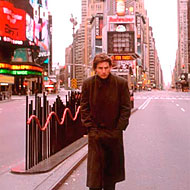Christopher Nolan’s Inception, opening this week, promises to be another leap forward for one of pop culture’s greatest devices: the dream sequence. The film pioneer Georges Melies filmed the first such sequence around the turn of the century, which means that it predates the close-up and even, to some extent, film editing. Over the decades, of course, we’ve gotten lots of dreams in movies and TV: From goofy ones that last a few seconds (think of any Family Guy episode) to entire seasons of TV shows that turned out to be dreams (think Dallas). The popularity of the dream sequence, however, belies the device’s many pitfalls. Here, then, are our ten rules for creating a dream sequence, paired off with the movies and shows that illustrate them.
Rule 3: Keep us within the movie.
We understand the thinking behind this: Put Tom Cruise in the middle of a completely empty Times Square to heighten his isolation and anxiety. But as soon as this dream arrives, you know what the audience is thinking: Wow, emptying Times Square must have cost a lot of money!
Rule 6: Characters should be slightly different in their dreams.
“Join the Club,” the second episode of the final season of The Sopranos, finds Tony Soprano lying in a coma, dreaming that he is an average suburban salesman named Kevin Finnerty. This whole living-in-an-alternate-reality thing has been done before, and we were wary of this plot development at first, but James Gandolfini’s performance makes this one work — chiefly because the character we see onscreen is slightly different from Tony Soprano, right down to the accent. All this, of course, heightens his character’s existential despair — like pretty much everything on The Sopranos.








